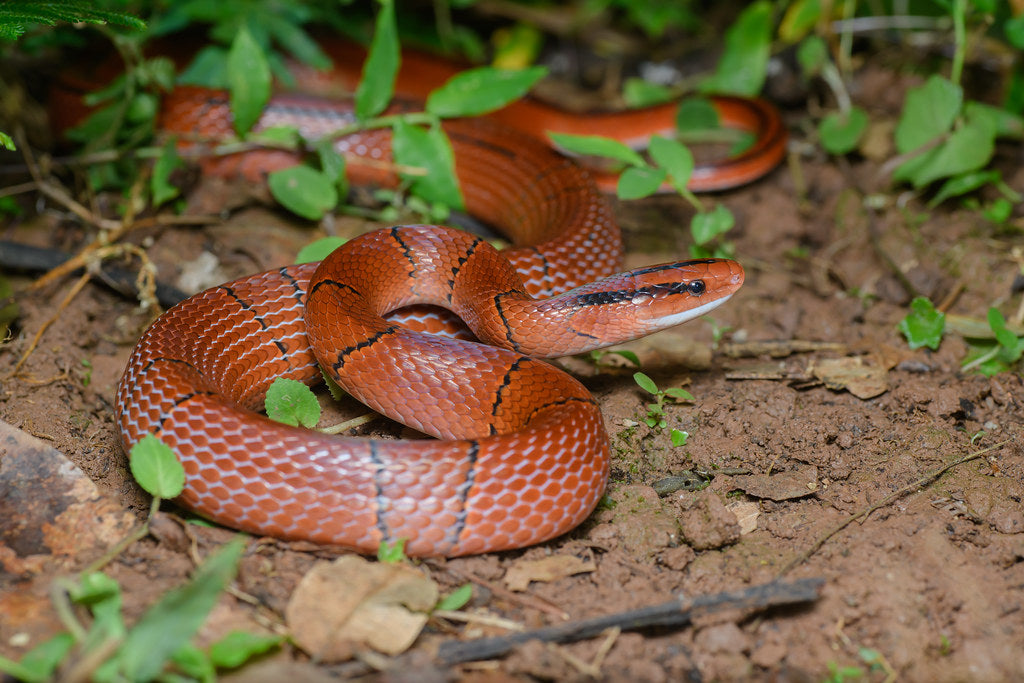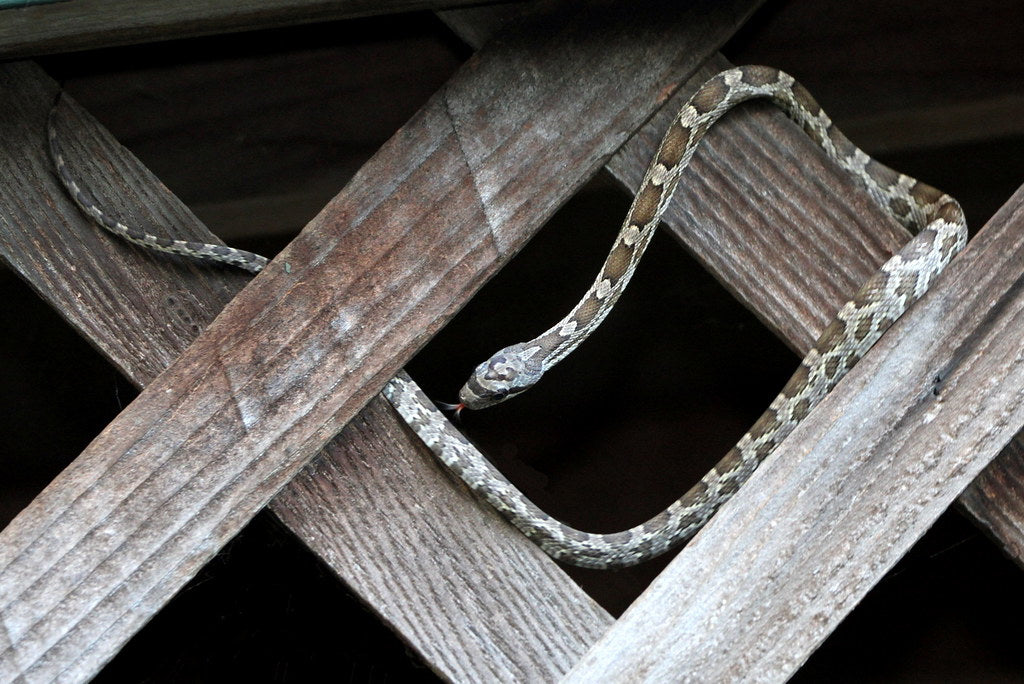Bamboo ratsnakes (Oreocryptophis porphyraceus) are small, terrestrial, nocturnal snakes native to east and southeast Asia. Their preferred habitat is montane forest, rainforest, and bamboo thickets, generally in mountainous regions.
Bamboo ratsnakes are generally 32-36” long, with a slender body, oval head, small eyes, round pupils, and smooth, glossy scales. Coloring and pattern varies by subspecies, but generally speaking, bamboo ratsnakes have a rusty red to bronze-brown base color with pairs of dark stripes down the length of its body, a stripe behind each eye, and another stripe on top of the head. Some individuals have dark, lateral stripes running the length of the body instead.
Bamboo ratsnakes are secretive animals that make intermediate-level pets due to their lower handling tolerance and high humidity needs.
How much space do bamboo ratsnakes need?
Like ball pythons, bamboo ratsnakes are popular for keeping in undersized tub-style enclosures due to their shy nature. However, this species still needs an enclosure that allows them to stretch out fully, thermoregulate, and explore as desired.
The minimum for appropriately keeping one bamboo ratsnake is 36”L x 18”W x 16”H, but larger is likely to be used. For the snake’s comfort (and reduced risk of escape), this enclosure should be front-opening and have opaque sides.
Cohabitation (keeping multiple bamboo ratsnakes in one enclosure) is not recommended, as this is not a social species.
Do bamboo ratsnakes need UVB?
While bamboo ratsnakes are capable of surviving without access to UVB, it’s still best practice to provide UVB lighting for optimal health and wellbeing. UVB gives reptiles all of the vitamin D that their bodies need, stimulates better appetite and activity, and generally allows them to be healthier than they would be without.
Here are the best UVB bulbs for bamboo ratsnakes:
- Zoo Med Reptisun T5 HO 5.0, 22”
- Arcadia Forest 6%, 22”
The UVB bulb should be housed in a reflective fixture such as Arcadia or Vivarium Electronics, and placed close to the heat lamp, about 9-11” above the snake’s back if over mesh, and 12-14” above the snake’s back if not. Make sure that the fixture your UVB bulb is in does not have a clear plastic or glass bulb cover, as these materials block UVB. UVB lighting also decays over time, so make sure to replace your bulb every 12 months to maintain its performance.
Bamboo ratsnakes should receive 13 hours of light per day during summer, and 11 hours per day during winter. This helps create a more natural hormonal cycle for them.
What basking temperatures do bamboo ratsnakes need?
Like other reptiles, bamboo ratsnakes are ectotherms, which means that they need a temperature gradient in their enclosure to help them regulate their metabolism and stay healthy.
That being said, bamboo ratsnakes prefer to stay cooler than most snakes. They should have a basking surface temperature between 80-84°F, down to 68-74°F on the cool side. It is very important that they have ready access to a cool area in the enclosure, or else they will get stressed and potentially die! Temperatures should be measured with an infrared thermometer.
Provide heat for your snake by imitating the sun with one or two moderate-wattage heat bulbs clustered on one side of the enclosure. This should create an area of gentle heat large enough to evenly heat the snake’s entire body when coiled. Do not use colored bulbs, as these are not as effective. If temps get too high, dim the bulbs with a plug-in lamp dimmer or proportional thermostat. If temps are too low, you need higher-wattage bulbs.
Alternatively, you can use a small heat mat sandwiched between a plastic box hide (bottom) and a piece of flat stone (top). This should be plugged into a thermostat set to 82°F to prevent it from getting dangerously hot. The thermostat probe should be placed inside the warm hide.
Heating should be turned off at night. Temperatures can get down to 60°F without a problem.
What humidity levels do bamboo ratsnakes need?
Bamboo ratsnakes need an environment that is humid and fairly damp, but not soggy. Provide daytime humidity levels between 70-80%, and nighttime humidity levels at 90%+.
Measure the humidity in your snake’s enclosure with a digital probe hygrometer placed in the middle of the enclosure. It’s also good practice to provide a humid hide for your snake on the cool side of the enclosure, lined with moistened sphagnum moss.
Misting your snake’s enclosure with a sprayer first thing in the morning and again at night will help create the right humidity levels. If you need more, pouring water into the substrate or using a cool-mist humidifier at night, connected to a hygrostat, is also helpful.
What substrate is good for bamboo ratsnakes?
Bamboo ratsnakes require a thick layer of moisture-retentive substrate to cushion their bodies, for burrowing, and to help maintain healthy humidity levels. As an added perk, it also tends to make the enclosure more attractive.
We recommend the following substrates for bamboo ratsnakes:
- Zoo Med Eco Earth
- Zoo Med ReptiSoil
- Exo Terra Plantation Soil
- Zilla Jungle Mix
- Galapagos Terrarium Sphagnum Moss
Adding a thick layer of clean, chemical-free leaf litter on top of the substrate can also help with humidity and provides additional cover to help your snake feel secure in its environment.
Substrate should be at least 3” deep and completely replaced every 2-3 months. Remove poop and urates daily, along with contaminated substrate.
What decor can you use in a bamboo ratsnake terrarium?
It’s terribly boring (and even stressful) for a snake to be stuck in an enclosure with nothing in it. It doesn’t matter how big the enclosure is if you don’t put things in it for your pet to use and interact with!
Aside from substrate and a big water bowl, here are some other things to include in your bamboo ratsnake’s setup:
- hides/caves
- low branches
- cork tubes/flats
- live/artificial plants
What do bamboo ratsnakes eat?
Like other snakes, bamboo ratsnakes are carnivores, which means that they need to eat whole animal prey in order to get the nutrition that they need. Here is a basic feeding schedule based on snake size:
- Juveniles should be fed once every 4-6 days.
- Adults should be fed once every 7 days.
Prey items should be between 5-10% of your snake’s weight and/or roughly the same width as its body. Although live prey can be used, it’s safest and most humane to use frozen instead. Prey should be thawed in a plastic bag in warm water to approximately 100°F before offering with a pair of soft-tipped tweezers.
Remember, the key to great nutrition is variety! Aside from offering young mice and rats, button quail can also be used to create nutritional variety in your snake’s diet.
Supplements
Bamboo ratsnakes can survive without vitamin or mineral supplements, but occasionally using them can help prevent nutritional deficiencies and optimize your snake’s health. We recommend Repashy Calcium Plus LoD.
Water
Your bamboo ratsnake should have access to clean, fresh water at all times. Provide a water bowl large enough for the snake to soak its entire body if desired. Change the water daily and scrub the bowl with a reptile-safe disinfectant weekly, or whenever it becomes soiled.
Do bamboo ratsnakes like to be handled?
Few reptiles actually “like” to be held, and bamboo ratsnakes generally prefer to be left alone. When threatened, they generally prefer to flee rather than bite, but they may bite when cornered. They can also be highly excitable, so it can be hard to hold on to them, and squeezing them only makes the problem worse.
If you need to pick up your snake, wear a pair of gloves, be gentle, and let the snake cruise from one hand to the other. Support as much of its body as possible, and NEVER pick up a snake by its tail!
*This care sheet contains only very basic information. Although it’s a good introduction, please do further research with high-quality sources to obtain additional information on caring for this species.
"Oreocryptophis porphyraceus pulchra, Red bamboo rat snake - Doi Phu Kha National Park" by Rushen! is licensed under CC BY-SA 2.0




Leave a comment
This site is protected by hCaptcha and the hCaptcha Privacy Policy and Terms of Service apply.